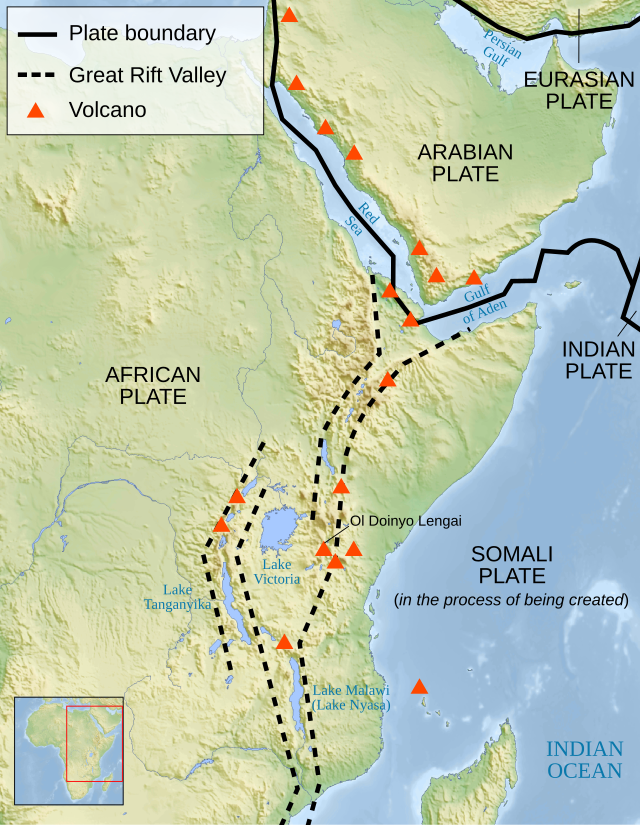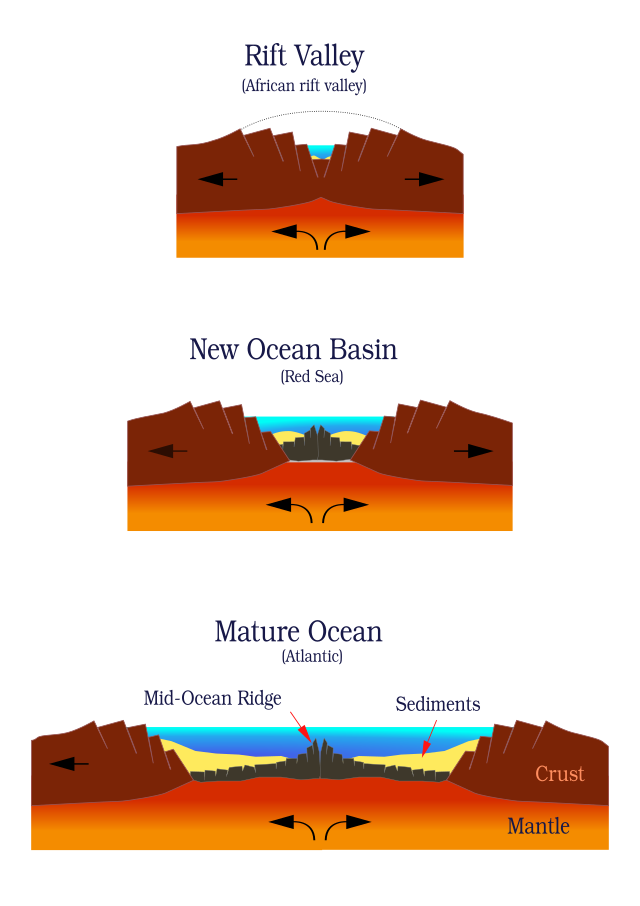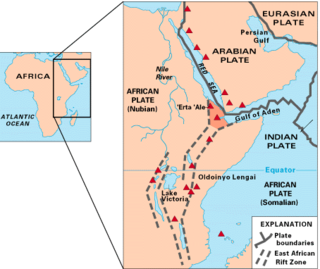Top Qs
Timeline
Chat
Perspective
Great Rift Valley
Continuous geographic trench from Asia to Southeast Africa From Wikipedia, the free encyclopedia
Remove ads
The Great Rift Valley (Swahili: Bonde la ufa) is a series of contiguous geographic depressions, approximately 6,000 or 7,000 kilometres (4,300 mi) in total length, the definition varying between sources, that runs from the southern Turkish Hatay Province in Asia, through the Red Sea, to Mozambique in Southeast Africa.[1][2] While the name remains in some usages, it is rarely used in geology where the term "Afro-Arabian Rift System" is preferred.[3]
This article needs additional citations for verification. (June 2024) |

This valley extends southward from Western Asia into the eastern part of Africa, where several deep, elongated lakes, called ribbon lakes, exist on the rift valley floor, Lake Malawi and Lake Tanganyika being two such examples. The region has a unique ecosystem and contains a number of Africa's wildlife parks.


The term Great Rift Valley is most often used to refer to the valley of the East African Rift, the divergent plate boundary which extends from the Afar triple junction southward through eastern Africa, and is in the process of splitting the African plate into two new and separate plates. Geologists generally refer to these evolving plates as the Nubian plate and the Somali plate.
Remove ads
Theoretical extent


Today these rifts and faults are seen as distinct, although connected. Originally, the Great Rift Valley was thought to be a single feature that extended from Lebanon[dubious – discuss] in the north to Mozambique in the south, where it constitutes one of two distinct physiographic provinces of the East African mountains. It included what today is called the Lebanese section[dubious – discuss] of the Dead Sea Transform (Turkey to Straits of Tiran[dubious – discuss]), the Jordan Rift Valley (geographic term for section including entire course of the Jordan River, the Dead Sea, and the Arabah Valley), Red Sea Rift, and the East African Rift.[4] These rifts and faults are considered to having been formed 35 million years ago.
Remove ads
Asia
The northernmost part of the Rift corresponds to the central[dubious – discuss] section of what is today called the Dead Sea Transform (DST) or Rift. This midsection of the DST forms the Beqaa Valley in Lebanon, separating the Mount Lebanon range from the Anti-Lebanon Mountains. Further south it is known as the Hula Valley separating the Galilee mountains and the Golan Heights.[5][failed verification][clarification needed]
The Jordan River begins here and flows southward through Lake Hula into the Sea of Galilee in Israel. The Rift then continues south through the Jordan Rift Valley into the Dead Sea, on the Israeli-Jordanian border. From the Dead Sea southwards, the Rift is occupied by the Wadi Arabah, then the Gulf of Aqaba, and then the Red Sea.[5]
Off the southern tip of Sinai in the Red Sea, the Dead Sea Transform meets the Red Sea Rift which runs the length of the Red Sea. The Red Sea Rift comes ashore to meet the East African Rift and the Aden Ridge, in the Afar Depression of East Africa. The junction of these three rifts is called the Afar triple junction.[5]
Remove ads
Africa
Summarize
Perspective



The East African Rift follows the Red Sea to the end before turning inland into the Ethiopian highlands, dividing the country into two large and adjacent but separate mountainous regions. In Kenya, Uganda, and the fringes of South Sudan, the Great Rift runs along two separate branches that are joined to each other only at their southern end, in Southern Tanzania along its border with Zambia. The two branches are called the Western Rift Valley and the Eastern Rift Valley.
The Western Rift, also called the Albertine Rift, is bordered by some of the highest mountains in Africa, including the Virunga Mountains, Mitumba Mountains, and Ruwenzori Range. It contains the Rift Valley lakes, which include some of the deepest lakes in the world (up to 1,470 metres (4,820 ft) deep at Lake Tanganyika).
Much of this area lies within the boundaries of national parks, such as Virunga National Park in the Democratic Republic of Congo, Rwenzori National Park and Queen Elizabeth National Park in Uganda, and Volcanoes National Park in Rwanda. Lake Victoria is considered to be part of the rift valley system although it actually lies between the two branches. All of the African Great Lakes were formed as the result of the rift, and most lie in territories within the rift.
In Kenya, the valley is deepest to the north of Nairobi. As the lakes in the Eastern Rift have no output to the sea and tend to be shallow, they have a high mineral content as the evaporation of water leaves the salts behind. For example, Lake Magadi has high concentrations of soda (sodium carbonate) and Lake Elmenteita, Lake Bogoria, and Lake Nakuru are all strongly alkaline, while the freshwater springs supplying Lake Naivasha are essential to support its current biological variety.
The southern section of the Rift Valley includes Lake Malawi, the third-deepest freshwater body in the world, which reaches 706 metres (2,316 ft) in depth and separates the Nyassa plateau of Northern Mozambique from Malawi. The rift extends southwards from Lake Malawi as the valley of the Shire River, which flows from the lake into the Zambezi River. The rift continues south of the Zambezi as the Urema Valley of central Mozambique.[6]
Remove ads
See also
- Africa
- Great Rift Valley, Ethiopia
- Great Rift Valley, Kenya
- Rift Valley fever
- Rift Valley lakes
- Rift Valley Province
- Rift Valley Railways
- Rift Valley Technical Training Institute
- The Great Rift: Africa's Wild Heart, a BBC/Animal Planet production
- Major earthquakes
Remove ads
References
Further reading
External links
Wikiwand - on
Seamless Wikipedia browsing. On steroids.
Remove ads
